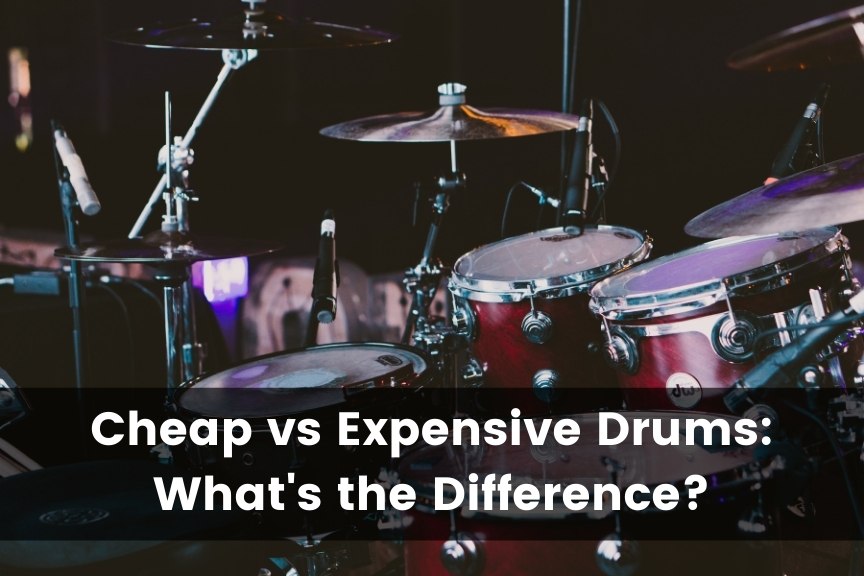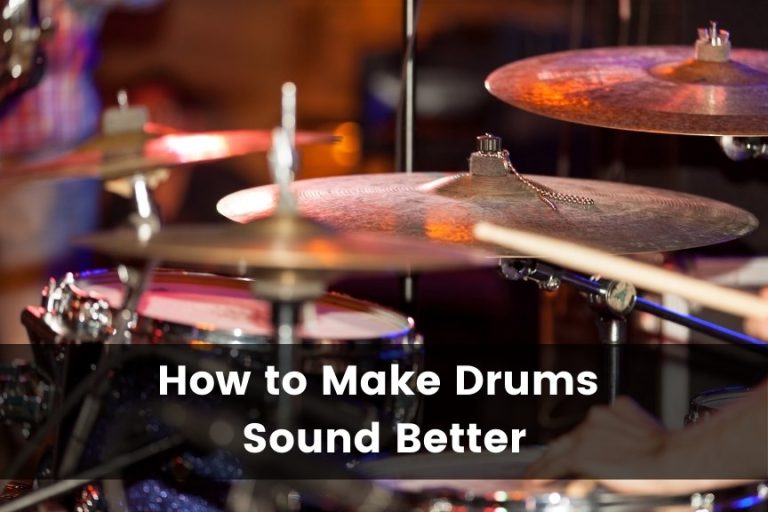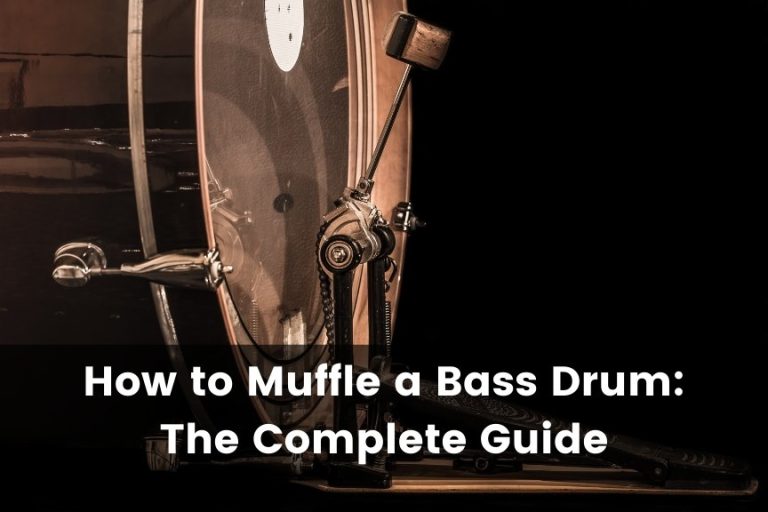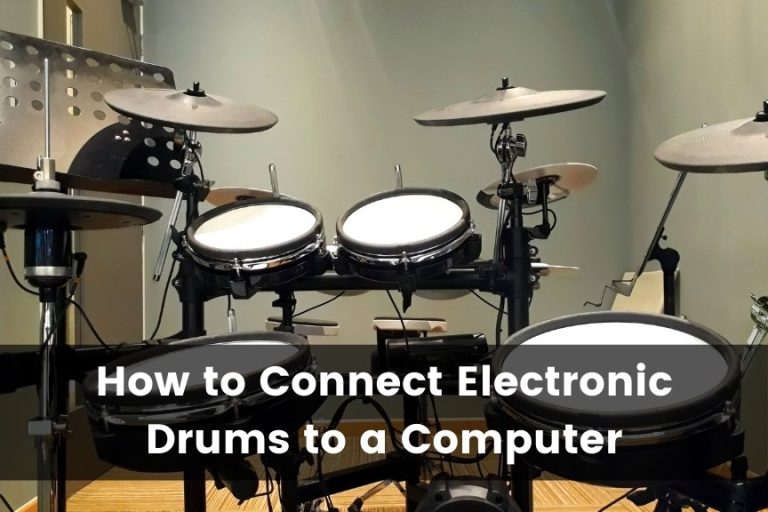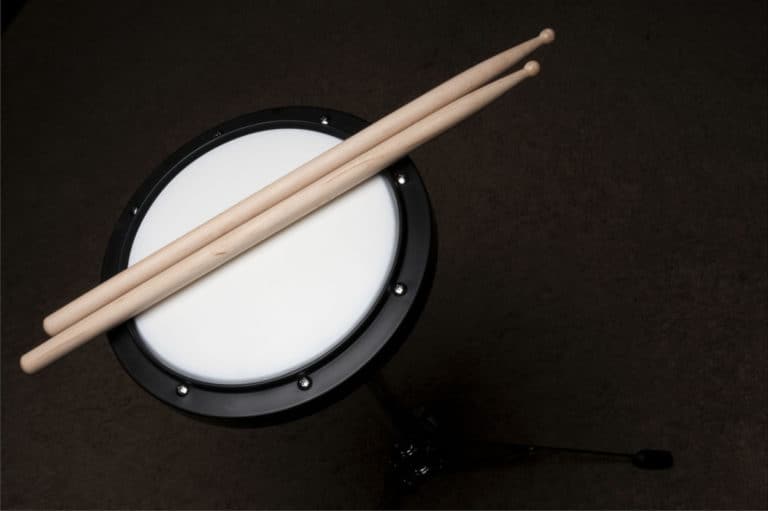Cheap vs Expensive Drums: What’s the Difference?
To the untrained ear, all drums — regardless of their cost — sound the same. Drummers like you, on the other hand, know better. But what exactly are the differences (if any) between cheap and expensive drums?
Cheap and expensive drum sets differ in terms of durability, sound, and feel. However, the drummer’s skills, the cymbals’ quality, and the drum set’s tuning can render the differences between cheap and expensive drums insignificant — at least, as far as overall performance is concerned.
Are you considering whether to buy a cheap or expensive drum set? In this article we’ll compare the differences between Cheap vs Expensive drums. We will answer some of your common questions on the matter and outline how cheap and high-end drum sets compare.
Is There a Difference Between Cheap and Expensive Drums?
Cheap and expensive drum sets are different in terms of the materials they are made of, meaning they do not sound the same. They also have different finishes and designs, so they look and feel different to drummers. Their overall performance may vary depending on the drummer’s skill, however.
There are a few ways to compare cheap and expensive drum sets.
For instance, the differences between cheap and expensive drum sets in terms of quality, design, and material are usually obvious even to the untrained eye.
However, the differences in their sound and feel aren’t as straightforward and require more in-depth knowledge of drumming.
A highly skilled drummer can tune and play a cheap drum set just as well as an expensive one with little to no difference to the untrained ear. On the other hand, it’s possible for a less skilled player to play a drum set poorly no matter how expensive or high-quality it is.
In other words, some drummers may be skilled enough such that the price and commensurate quality of their drum set make little (if any) difference to their playing.
Setting the player’s ability aside, expensive drum sets usually have fewer overtones than cheaper ones, which makes for better sound. Usually, cheap drum sets produce loud overtones rather than clean drum sounds when hit.
Additionally, cheap drum sets produce noises like vibrations at the bearing edge because of the drum heads’ design. Expensive drum sets usually have sturdier drum heads to minimize unwanted noises as they’re being played.
How Are Cheap Drums Made?
Cheaper drum sets are typically made from thinner ply shells, cheaper wood, and other relatively inexpensive materials. They also have looser drum heads than higher-end drum sets. In general, drum sets vary in the quality of materials used and design.
Below is a more in-depth look at what sets cheaper drum sets apart from more expensive varieties.
- Cheaper drum sets usually have looser drum heads. This causes them to produce additional noise from vibrations and overtones while you play. These overtones can add a nice musical element in some genres.
- Cheap drums are usually made from cheaper wood and other materials than high-end ones. The cheap wood makes for less durable drums that don’t absorb polish well. That means they don’t look as good as the pricier options.
- Cheap drums are less durable than their more expensive counterparts. Cheaper drums are made with thinner and fewer ply shells. Expensive drum sets, on the other hand, use more ply shells that are closely bonded to reinforce the drum’s quality and enhance the sound it produces.
Overall, it would seem that you shouldn’t use cheap drum sets at all. However, as I’ll explain later in this article, just because a drum set has a lower price tag doesn’t mean you should completely write it off.
Why Are Some Drum Sets More Expensive?
Some drum sets are more expensive because of their sound quality, durability, finish, and aesthetic appeal. Other factors such as branding also contribute to higher costs.
Let’s take a closer look at factors that affect a drum set’s price.
Drum Shell Construction
The drum shell is essentially the skeleton of your drum. It’s what’s left after you remove the drum heads, rims, lugs, and tension bolts. Cheaper drums often use basswood or plywood, while higher-end drums use a sturdier hardwood construction. Intermediate and advanced drum sets typically use the likes of oak and maple wood.
Drum Finishes
When you say “drum finish,” you refer to the drum set’s overall look. There are multiple drum finishing options, including plastic wraps, lacquers, oils, and even exotic finishes. Cheaper drum sets use plastic wrapping, while high-end drum sets use more expensive options such as oil to produce a more aesthetically appealing look.
Sound Quality
As I’ve mentioned, high-end drum sets are made from quality materials to help produce the best sound possible. They also have better tuning capacity and little to no additional noises from vibrations and overtones. Since crafting the drums for the best sound quality takes more skill, they naturally cost more.
Durability
While some cheap drum sets can produce quality sound, they typically don’t last as long as more expensive ones. That makes them unreliable for long engagements such as tours. Therefore, high-end drum sets cost more because they can perform for far longer without breaking.
Projection
Some drums are costlier because they project better sound than the cheaper options. Expensive drum sets are fitted with better quality hardware, so they can produce better, cleaner, and louder sounds even when you don’t strike them too hard. This means you can play the drums more efficiently without tiring out quickly — which comes in handy for tours and hours-long concerts.
Branding
Of course, if your drum set’s brand has a solid reputation for quality products, they can afford to charge more for them. That’s because they’re aware that most of their customers are willing to pay top dollar for their offerings because their extra investment will pay off over the long run.
On the other hand, it’s possible that a drum set from a less well-known brand can perform just as well as their more expensive counterparts for a lower price. Therefore, if budget is a top priority of yours, you need to keep an eye out for these ones. You can also ask around via online forums on the best cheap drum sets.
Are Expensive Drums Better Than Cheap Ones?
Expensive drum sets are generally better than cheaper ones in many ways. However, whether they are better overall will ultimately depend on your personal preferences and playing skills.
For example, some drummers prefer the loose drum heads on cheaper drum seats because they can produce a fuller tone with the overtones adding to the effect.
Another reason some players prefer cheaper drums is that expensive drum sets ring for a lengthier period after playing and have a more controlled decay and focussed notes.
Moreover, some beginners often struggle to work with high-end drums because they require more time to tune. Beginners already have their hands full learning proper techniques, so tuning may be the last thing on their minds.
Therefore, you should always try out a drum kit to know whether it’s up to par for you.
That said, expensive drum sets are functionally better than cheaper options for the following reasons:
- They lack overtones: Expensive drum sets are designed with firm drum heads to minimize overtones and vibrations that aren’t ideal for some genres.
- They have a wider tuning range: Expensive drum sets have a wider tuning range, allowing you to tune the drums lower and higher than cheaper drums.
- They don’t lose their tuning: Expensive drum sets are designed this way because of their intended use. Since professional drummers often use their drumming kits for rehearsal and practice, they need reliable drums that can stay in tune.
- They’re more durable: Expensive drums are typically made with professional drummers in mind. These professionals need reliable drum sets they can play anywhere — in the studio during recording sessions, live performances, and practice sessions. High-end drum sets are durable enough for all of these.
- They use better finishes. Compared to cheaper options, expensive drums use better finishes that don’t chip off easily even after several drumming sessions. They also have soft cushions under the springs to enhance the drum’s sound, look, and feel.
Are Expensive Drums Worth It?
Expensive drum sets are not always worth it depending what you’ll be using it for and your experience level. In some cases, cheaper drum sets are the better option. For instance, practice sessions often emphasize technique over sound quality. Using cheaper drums for practice sessions will prevent overall wear and tear on your more expensive drum kits. Therefore, you do not need expensive drum sets in all situations.
Some may assume that expensive drum sets are always the correct choice. However, cheaper drum sets may be better under certain circumstances.
For example, practice sessions usually involve a lot of repetitive work that focuses on mastering the techniques and songs rather than the sound quality of the performance.
Furthermore, using your expensive drum sets for practice may reduce their lifespan, meaning you’ll have to pay more for a replacement should your drum sets get damaged.
In my opinion, beginners should consider purchasing cheaper drum sets first before scaling up to more expensive ones. This gives you enough time to master your craft and better understand what type of quality or material you prefer. Also, you can avoid a situation where you buy an expensive birch drum set only to realize that you actually play better on maple drum sets.
Of course, the flip side to this is that when you move on to more expensive sets, you have to train your ear harder to know that you’re making the right sounds. If you initially practiced on expensive sets that have good sound, you don’t have to adjust your ears as much compared to initially practicing on cheap drums.
Can You Hear the Difference Between Cheap and Expensive Drums?
It is possible to hear the difference between a cheap and expensive drum set. Of course, this is difficult for untrained ears. Professionals who are used to playing different drum sets can often distinguish quality from cheap drum sets by ear.
Testing the difference in the quality of two drum sets isn’t only a matter of listening to them while they’re being played. The playing alone doesn’t account for heads, tuning, and shell size variations. When you’re choosing between drum sets, make sure they have similar skins and drum sizes so you’ll have a more accurate picture of their differences in quality.
Can I Improve a Cheap Drum to Produce Better Sound?
You can improve a cheap drum to produce better sound. For example, you can tune them properly, install new drum heads, and use strategic muffling. These options, coupled with a good playing technique, can significantly improve a cheap drum set’s sound quality.
Here’s what you can do to improve the sound quality of cheap drums.
Tune Your Drums Properly
One of the main problems with cheaper drum sets is that they’re difficult to tune. They also tend to lose their tuning faster than their more expensive counterparts. And if you don’t know how to tune your drums at all, expect a significant dip in sound quality. Therefore, one way to significantly improve cheap drums is to tune them well.
If you’re not sure how to tune your drums, you can use a Tune-Bot Studio TBS-001 Digital Drum Tuner (available on Amazon). It helps you to measure sound or voltage from your drum set and allows you to tune the entire drum kit at intervals.
Of course, if you want your tuning skills to benefit for the long haul, I suggest reading a book like “Learning Drums On Your Own: Tune A Drumset” by Digna Cipolloni (available on Amazon.com). Not only will it tell you how to tune a drum set, but you’ll also learn the other basics of using a drum set — how to choose one, how to troubleshoot poor sound, etc.
Invest in Better Cymbals
Cymbals are important enough to the point that some drummers argue that they matter more than the quality of the drum itself. Upgrading to quality cymbals can significantly transform your drum set for the better and enhance your playing experience.
If you want a new set of cymbals, I recommend the Zildjian I Family Standard Gig Cymbal Pack (available on Amazon). They’re light enough and can still produce the sound you’re looking for while being within budget.
When you’re buying new cymbals, keep the following tips in mind:
- Get a good idea of what you want your new cymbals to look and sound like.
- Bring someone with you while you’re buying cymbals — preferably another drummer.
- While at the store, ask for permission to play their cymbals using your own drum sticks. Test what the cymbals sound like from different distances (that’s where your drummer friend can come in handy)
Use Drum Heads With Better Resonance
Drum manufacturers usually install fairer-quality drum heads on cheaper drum sets than those used on expensive ones made by specialist companies such as Aquarian, Remo, and Evans. Cheaper drum heads can have a good enough resonance that can make a difference in your drum’s overall sound quality.
When looking for drum heads, you may find coated and clear drum heads. While coated drum heads generally produce a drier sound better for playing jazz, they’re not necessarily better than clear ones except for a better aesthetic appeal.
Always check the drum heads for signs that they may be faulty or inefficient, such as scratching, pitting, and discoloration. Quality drum heads with good sound are made from material that doesn’t chip or dent easily after repeated drumming.
Use Strategic Muffling
Muffling is an audio effect that makes voices sound distant, improving the sound produced by the drums. There are numerous muffling techniques you can use to limit your drum’s sound and control its tone and resonance, such as using pillows. If you want to muffle your drum sets, you should probably start with the bass drum. This is because the bass drum usually has the most overtone and resonance.
Otherwise, always use the correct muffling technique for your bass drums, toms, and snare drums to improve their sound significantly.
Experiment With Different Drumming Sticks
Another way to improve the sound from a cheap drum set is to try different drum sticks. A drum stick’s quality and type usually affect how the drum and the cymbal sound. Consider experimenting with wood or nylon tips because these typically produce brighter sounds.
If you’re interested in drum sticks with wooden tips, I recommend the Vater 7A Wood Tip Hickory Drum Sticks, Pair (available on Amazon). They’re comfortable and made from slip-resistant material to improve your grip and enhance the drumming experience.
For drumsticks with nylon tips, consider the Vic Firth American Classic 5AN (available on Amazon). They’re designed with great all-around size and weight, which makes them versatile. In addition, the nylon tip adds clarity and durability to your cymbals.
Conclusion
Having a high-quality drum set enhances your ability to play well. And better quality usually comes with higher prices. However, expensive drum sets aren’t always the answer. Instead, you should focus on improving your playing and tuning skills to ensure you can make the most of cheap or expensive drum sets.

